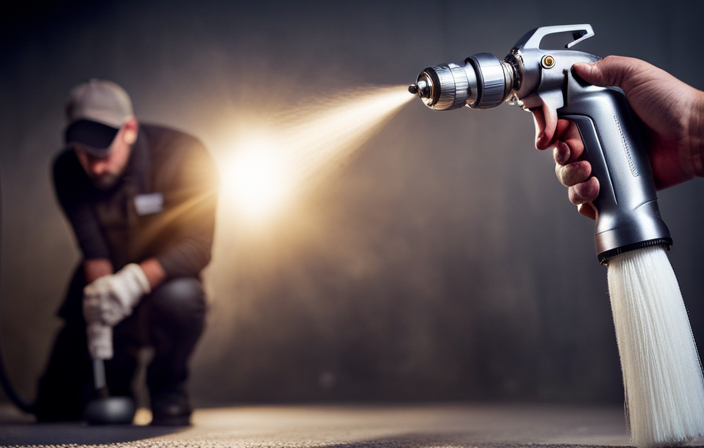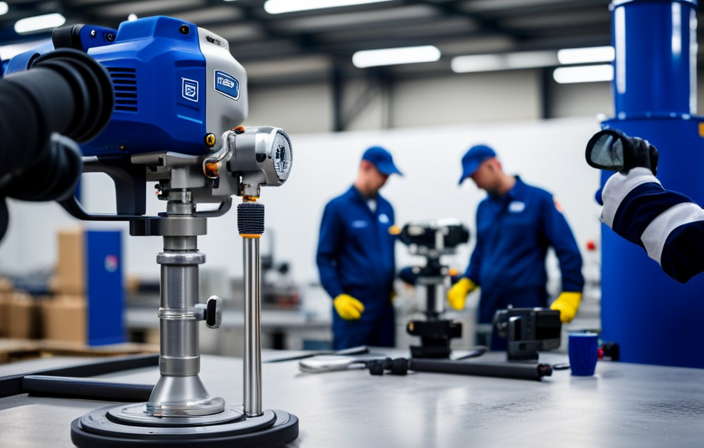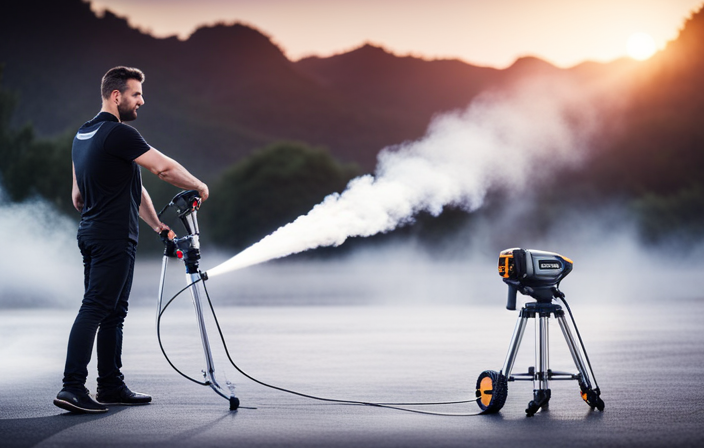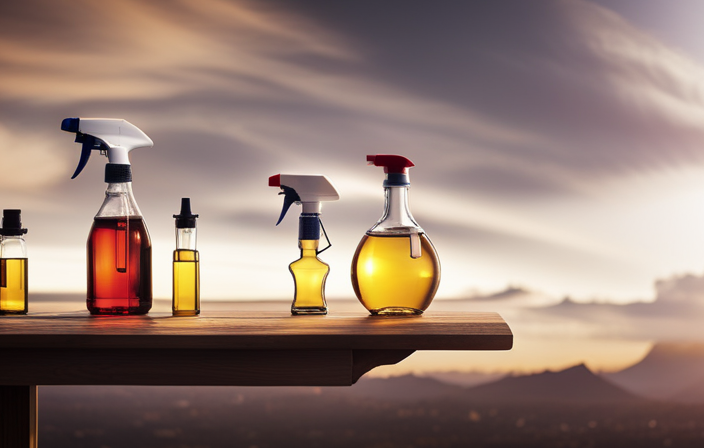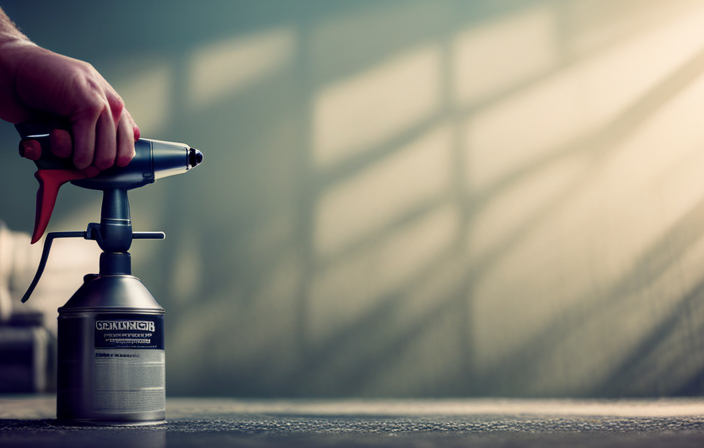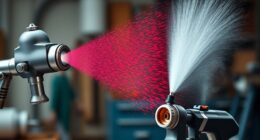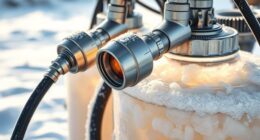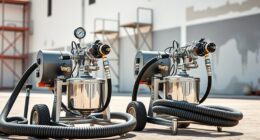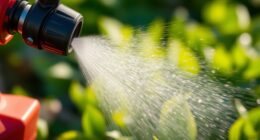Did you know that nearly 80% of issues with airless paint sprayers can be easily fixed without the need for professional help? If you’re having trouble with your airless paint sprayer, don’t worry – I’m here to assist you.
In this article, I will share my knowledge and expertise on troubleshooting common issues, cleaning and maintenance tips, adjusting pressure settings, choosing the right spray tip, and proper technique for using an airless paint sprayer.
I’ll also provide important safety precautions to ensure a smooth and accident-free painting experience. With my detailed and precise instructions, you’ll be able to fix your airless paint sprayer and get back to your painting project in no time.
So, let’s dive in and learn how to fix your airless paint sprayer like a pro!
Key Takeaways
- Clogging issues can be resolved by checking and cleaning the paint filter.
- To achieve an even spray pattern, align the nozzle and adjust pressure settings.
- Low pressure can be caused by wear or clogs in the pump and hose.
- Following the manufacturer’s troubleshooting instructions is essential for resolving issues with the airless paint sprayer.
Troubleshooting Common Issues with Your Airless Paint Sprayer
If you’re experiencing issues with your airless paint sprayer, don’t worry, I’ve got you covered with some troubleshooting tips.
Common problems with airless paint sprayers include clogging, uneven spray pattern, and low pressure.
To troubleshoot clogging, start by checking the paint filter for any debris and clean it if necessary.
If the spray pattern is uneven, make sure the nozzle is properly aligned and not worn out. Adjusting the pressure settings may also help.
Low pressure can be caused by a worn-out pump or a clogged hose, so check those components as well.
Remember to always follow the manufacturer’s instructions when troubleshooting your airless paint sprayer.
Now let’s move on to cleaning and maintenance tips for your airless paint sprayer.
Cleaning and Maintenance Tips for Your Airless Paint Sprayer
To keep your airless paint sprayer in good working condition, it is important to regularly clean and maintain it. This will ensure optimal performance and longevity. Proper cleaning techniques are essential to prevent clogs and maintain the sprayer’s efficiency. After each use, flush the sprayer with water or a cleaning solution to remove any leftover paint. Pay special attention to the nozzle and filters, as they are prone to clogging. If you encounter any issues, such as uneven spray or loss of pressure, troubleshooting problems can often be resolved by cleaning and inspecting these areas.
Regular maintenance also includes checking for loose or worn parts, lubricating moving components, and storing the sprayer in a clean and dry environment. By following these cleaning and maintenance tips, you can ensure that your airless paint sprayer functions at its best, allowing you to achieve optimal spray performance.
Adjusting Pressure Settings for Optimal Spray Performance
Achieving the perfect spray performance is all about finding the right pressure settings for your equipment.
When using an airless paint sprayer, it is essential to adjust the nozzle pressure to ensure an even and consistent spray pattern. Start by checking the manufacturer’s instructions for the recommended pressure range for your specific sprayer model.
If the spray is too thick or uneven, you may need to increase the pressure slightly. Conversely, if the spray is too thin or overspraying, you can decrease the pressure.
Troubleshooting clogging issues can also be resolved by adjusting the pressure settings. By finding the optimal pressure for your paint and project, you can achieve a professional finish.
Now, let’s move on to the next step and discuss choosing the right spray tip for your project.
Choosing the Right Spray Tip for Your Project
When it comes to choosing the right spray tip for your project, there are a few key points to consider.
Firstly, understanding the different spray tip sizes and their uses is essential.
Secondly, selecting the proper tip for the type of paint you’re using can make a big difference in the quality of your spray job.
Lastly, there are tips and techniques you can employ to achieve the desired spray pattern and coverage, ensuring a professional finish.
Understanding Different Spray Tip Sizes and Their Uses
Master the art of using different spray tip sizes and their respective uses to achieve flawless results with your airless paint sprayer. Understanding spray tip maintenance and the importance of spray fan size is crucial for a successful paint job. Different spray tip sizes are designed for specific types of projects and paints, allowing for precise control over the application.
To help you understand the different spray tip sizes and their uses, refer to the table below:
| Spray Tip Size | Recommended Uses |
|---|---|
| 0.011 inch | Fine Finishing |
| 0.015 inch | Stains, Sealers |
| 0.017 inch | Enamels, Varnishes |
By using the appropriate spray tip size, you can ensure an even coat of paint and minimize overspray. Now that you understand the significance of spray tip sizes, let’s move on to selecting the proper tip for the type of paint you’re using.
Selecting the Proper Tip for the Type of Paint You’re Using
To ensure optimal results, it’s important to choose the right spray tip size based on the type of paint you’re using. This can increase the efficiency of your project by up to 30%. Selecting the proper tip for the type of paint can greatly enhance the performance of your airless paint sprayer. It allows for precise control of the paint flow and ensures an even application.
One important aspect to consider is spray tip maintenance. Regularly cleaning the spray tip and checking for any clogs is essential to avoid any disruptions in the paint flow. Troubleshooting paint clogs can be done by using a cleaning solution or a small brush to remove any debris.
By taking proper care of your spray tip, you can prevent any issues and achieve a smooth and consistent spray pattern. This will be further discussed in the next section, which focuses on tips for achieving the desired spray pattern and coverage.
Tips for Achieving the Desired Spray Pattern and Coverage
To achieve the desired spray pattern and coverage, follow these tips:
-
Choose the right spray tip size: Different tip sizes create different spray patterns. Use a smaller tip for thin paints and a larger tip for thicker paints.
-
Adjust the pressure: Higher pressure creates a finer spray pattern, while lower pressure creates a wider pattern. Adjust the pressure based on the desired coverage and the thickness of the paint.
-
Maintain a consistent distance: Keep the sprayer at a consistent distance from the surface being painted to ensure an even application. This distance may vary depending on the type of paint and the desired finish.
-
Clean the spray tip regularly: Paint clogs can occur if the spray tip becomes blocked. Clean it regularly with a brush or tip cleaner to prevent clogs and maintain optimal performance.
By following these tips, you can achieve smooth finishes and troubleshoot any paint clogs that may occur.
Now, let’s move on to discussing the proper technique for using an airless paint sprayer.
Proper Technique for Using an Airless Paint Sprayer
When using an airless paint sprayer, it’s crucial to hold the sprayer at the correct distance from the surface. This ensures that the paint is evenly distributed and prevents any streaks or drips.
Maintaining a consistent speed and motion is also essential for achieving a smooth and professional finish. This means moving the sprayer in a steady back-and-forth or up-and-down motion, depending on the surface being painted.
Lastly, overlapping sprays is necessary to ensure even coverage and avoid any patchy areas. This means starting each new pass slightly overlapping the previous one.
By following these key points, you can achieve excellent results with your airless paint sprayer.
Holding the Sprayer at the Correct Distance from the Surface
Mastering the art of holding the sprayer at the correct distance from the surface is essential for achieving a flawless and even coat of paint. Just like a painter waltzing with their brush, you need to find the perfect balance. To start, choose the right nozzle size for your project, keeping in mind that larger nozzles create wider spray patterns. Hold the sprayer about 12-16 inches away from the surface to achieve optimal coverage and avoid overspray. It’s important to maintain a consistent distance throughout the painting process to ensure an even coat. Remember, holding the sprayer too close can lead to paint build-up, while holding it too far away may result in uneven coverage. By mastering this technique, you’ll lay the foundation for a beautifully painted surface.
Now, let’s move on to the next section, which covers maintaining a consistent speed and motion.
Maintaining a Consistent Speed and Motion
To ensure a flawless finish, it’s important to keep a steady pace and fluid movement while using the sprayer. Maintaining a consistent speed and proper motion is crucial for achieving an even and professional-looking paint job.
When using an airless paint sprayer, it’s essential to move the sprayer in a smooth back-and-forth motion, keeping it at a consistent distance from the surface. This will help prevent any streaks or uneven coverage.
Additionally, maintaining a steady speed throughout the spraying process is important to ensure an even application of paint. By moving too quickly or too slowly, you risk creating drips or thin spots on the surface.
Now, let’s move on to the next section about overlapping sprays for even coverage.
Overlapping Sprays for Even Coverage
Achieving a flawless finish requires maintaining a consistent speed and motion, and one important technique to ensure even coverage is overlapping sprays. By using the overlap technique, you can achieve a smooth finish that hides any imperfections and creates a seamless look. This technique involves overlapping each spray pass by around 50% to ensure that every inch of the surface is covered. To help visualize this process, refer to the following table:
| Spray Pass | Spray Width |
|---|---|
| 1 | 12 in |
| 2 | 6 in |
| 3 | 3 in |
| 4 | 1.5 in |
Starting with a wider spray width in the first pass and gradually decreasing it in subsequent passes allows for an even distribution of paint. This technique ensures that no areas are missed and prevents streaks or unevenness. As you finish mastering the overlap technique for even coverage, it’s important to also keep in mind the safety precautions to take when using an airless paint sprayer.
Safety Precautions to Take When Using an Airless Paint Sprayer
Before using an airless paint sprayer, be aware of the necessary safety precautions. Safety equipment is essential. Always wear protective goggles, gloves, and a respirator. Ensure the work area is well-ventilated. Regularly maintain the sprayer to minimize accidents. Clean it after each use and inspect for damage or wear. Replace worn-out parts and tighten loose connections. By following these precautions and maintaining the sprayer, ensure a safe painting experience.
Frequently Asked Questions
Can I use an airless paint sprayer for both interior and exterior painting projects?
Absolutely! An airless paint sprayer is perfect for both interior and exterior projects. It provides efficient coverage and saves time. Whether you’re painting walls or outdoor surfaces, this tool is a game-changer.
How often should I clean my airless paint sprayer?
I should clean my airless paint sprayer after every use to ensure optimal performance and longevity. Regular maintenance includes flushing the system with mineral spirits, cleaning the filters, and inspecting for any clogs or damage. Proper cleaning and maintenance will help avoid issues and extend the lifespan of the sprayer.
What is the ideal pressure setting for spraying latex paint?
The ideal pressure setting for spraying latex paint is typically between 1500-2000 PSI. This range allows for proper atomization without causing excessive overspray. Adjusting the pressure can be done on the sprayer’s control panel.
How do I determine the right spray tip size for my specific paint project?
To determine the right spray tip size for your specific paint project, consider the type of paint being used, the surface you’re painting, and the desired finish. Consult the manufacturer’s guidelines for recommended tip sizes and experiment to find the best fit.
Are there any specific safety measures I should take when using an airless paint sprayer around electrical outlets or wiring?
When using an airless paint sprayer near electrical outlets or wiring, it’s important to take electrical safety precautions. Make sure to turn off power to the area, cover outlets and wiring with plastic, and avoid paint splatters near them.
Conclusion
In conclusion, maintaining your airless paint sprayer is paramount to its performance and longevity. By troubleshooting common issues, cleaning and maintaining the sprayer, adjusting pressure settings, and choosing the right spray tip, you can achieve optimal spray performance.
Remember to use proper technique and take safety precautions when using the sprayer. With these tips in mind, you can ensure a smooth and efficient painting experience.
So, stay savvy and spruce up your space with an airless paint sprayer!
